Bonham's Texas & Pacific Roundhouse
Oscar Jefferson Jones was born in Bonham on June 24, 1867. By the age of thirteen he was working as a night caller at the Texas & Pacific (T & P) roundhouse in Sherman. An article in the December 22, 1940 Dallas Morning News noted that a key memory for Jones was when he "helped move the roundhouse from Sherman to Bonham. . . ."
Skeptics might find it hard to believe that Sherman started out as the T & P division station, complete with roundhouse and perhaps other repair shops, only to lose it all to Bonham. Nonetheless, newspaper clippings from the 1880s seem to support Jones's story.
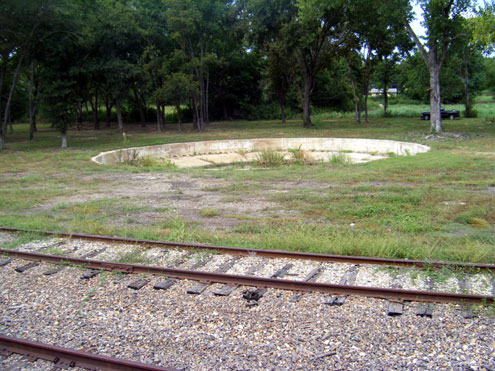
The Bonham News of November 19, 1880 reported: "Dr. Puckett, who saw Tom Scott and the other T & P magnates at Texarkana last Friday, informs us that it is the intention of this company to locate their machine shops . . . either at Bonham or Paris." (The 1880 census shows a Dr. John Puckett and family living in Bonham.)
By the following spring it seemed certain that Bonham was the lucky winner. "A letter is reported to have been received in this city Wednesday," noted the Bonham News of May 13, 1881, "stating that the officials of the T & P Railroad have finally concluded to make Bonham the division station between Fort Worth and Texarkana."
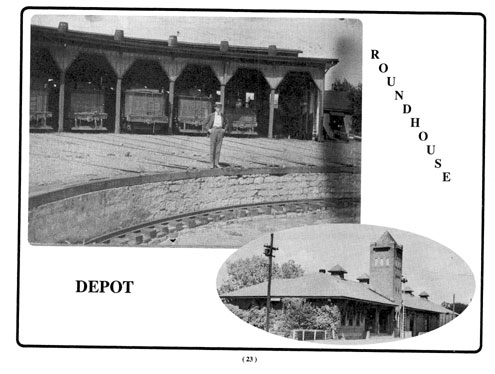
Telling the other side of the story is difficult because Sherman newspapers on microfilm don't reach back that far. However, referring to a Sherman paper, the Bonham News of June 10, 1881 noted that the "Sherman Courier Chronicle virtually concedes that the division terminus of the T & P Railroad will be removed from that city to Bonham within the next sixty days."
Later Sherman papers offer some clues as to the events that transpired in the early 1880s. The Sherman Register of July 30, 1886 reported that the "old Texas and Pacific turn table" had become a dangerous playground for children. Perhaps the "old" T & P turntable had been abandoned because it no longer served an adjoining roundhouse?
Various economic and infrastructure improvements in Sherman caused local leaders to believe that the city might get its division station, and perhaps the roundhouse, back. The editor of the Sherman Register put it rather bluntly in the January 29, 1887 issue:
The divisional facilities at Bonham are being neglected, while a glance at the Sherman yards shows a special crew at work, putting in improved switches, steel rails, new cross ties, etc. . . . The facts are too apparent. Sherman is the proper place for the divisional station, and out of eternal fitness of things, has grown the intention to put it back here.
Dispatches from Sherman that appeared in the Dallas News echoed the Sherman Register's argument. The August 4, 1886 issue noted that the "Texas and Pacific people express themselves as being very anxious for Sherman to get a good water supply here, and it is thought that they will move their roundhouse, etc., from Bonham, as Sherman is virtually the end of business" on the rail line.
The February 7, 1887 issue of the News reported that Sherman was working diligently to improve its water system while Bonham was simultaneously suffering from a lack of water, a crucial ingredient in keeping steam locomotives moving. It further reported that the T & P had to "keep two water trains running into [Bonham] in order to keep a large enough supply on hand." The article basically concluded by saying that Sherman had a shot at becoming the divisional station again once its water system was in place.
Despite the hopes and ambitions of Sherman leaders, Bonham remained the divisional station, and thus kept its roundhouse and adjoining turntable.
Judging from the newspaper clippings and the Oscar Jones story, it is safe to assume that the T & P roundhouse and turntable landed in Bonham by late 1881 or early 1882. Perhaps one of the earliest references to it in print came in W. A. Carter's A History of Fannin County, published in 1885. Carter wrote: "The round-house and machine shops of this division of the T. & P. are situated at Bonham, making quite an addition to the wealth, population and appearance of the city."
Throughout the 1880s and early 1890s the employees of the roundhouse kept busy maintaining and making repairs to the many steam locomotives that rolled through Bonham. In fact, the roundhouse itself eventually needed attention. The Dallas News of February 28, 1893 noted that the "building force of the Texas & Pacific Railway" was making repairs "on the roundhouse at Bonham."
As noted earlier, Bonham tended to suffer from a lack of water in the late 19th century. Such was not the case in the early summer of 1903. The impact of a powerful storm on Bonham and the T & P rail yards would be talked about for years, perhaps decades, to come.
Around 11:30 on the night of July 2 a light rain began falling. Shortly after midnight it was a full blown storm. The Dallas News of July 4 stated that the "rain fell in solid sheets, and with the deep thunder and continuous flash of lightning caused consternation everywhere throughout the city. Streets," it further noted, "were converted into rivers, water being from three to six feet deep all over town . . . ."
The July 5, 1903 Fort Worth Telegram reported that the rain "continued with a downpour until 6 o'clock without the least intermission."
Both newspapers reported that an accurate gauge - the Telegram called it a "government rain gauge" - showed the storm had dumped over thirteen inches of rain on Bonham.
By 1909 the Dallas News was carrying reports of plans by T & P officials to build a new roundhouse in Bonham. The June 25, 1909 issue of The Bonham Daily Favorite carried a headline stating the same. It reported that "Maj. B. S. Wathen, chief engineer for the T & P, spent last night in the city . . . ." Wathen told a Favorite reporter that work would "'commence probably the middle of next month.'" He further stated that "'a shop will be installed and everything needed to make it modern, and necessary for the rapidly increasing business.'"
Wathen finally added that the "'house will be some fifteen feet deeper and also made higher so that it will accommodate the largest engines now used by the T. & P.'"
The Dallas News of August 23, 1909 noted that work on the new roundhouse in Bonham had begun, with "a large force of men having been brought here from Marshall to assist in the building."
For unknown reasons there were occasional work delays on the new facility. However, by early 1910 all was back on schedule. The Dallas News of February 25 noted that work "resumed yesterday on the new roundhouse for the Texas and Pacific."
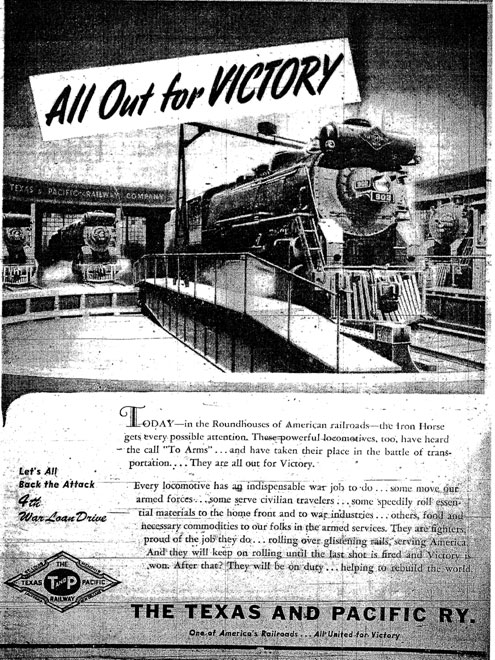
Since steam locomotives at that time were largely coal burners, T & P officials also decided that the yards in Bonham needed to supply more coal. The Daily Favorite of March 1, 1910 notes that "in connection with building the new roundhouse," T & P "is erecting new coal bins." It also stated that the new bins should "hold 60 days supply of coal."
A careful scanning of newspapers on microfilm failed to find exactly when the new roundhouse was ready for business. However, it is safe to assume that it was finished by the summer of 1910.
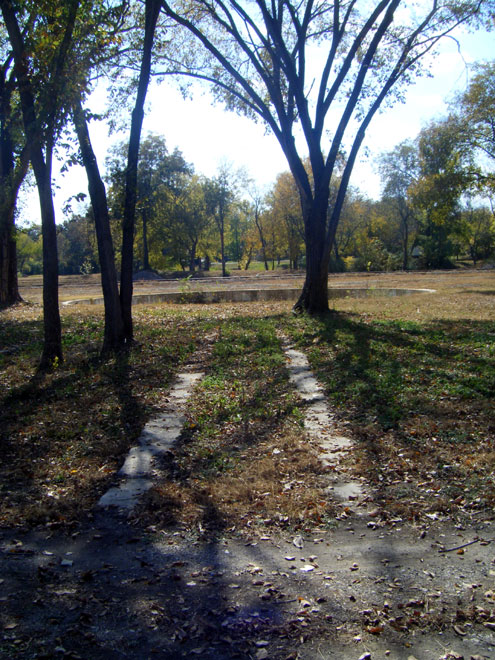
It was decided by late 1920 that the bigger roundhouse needed a better adjoining turntable. The December 4, 1920 Bonham Daily Favorite reported that work began "a few days ago on excavations for an electric turntable for the Texas and Pacific Railway. It will be seventy-five feet long and will occupy the space of the old one which has proved inadequate."
The Dallas News of December 8, 1920 reported that the old turntable "is not long enough to serve the big engines the road sometimes uses here, known as the D-10 and D-9 class, and handle them expeditiously."
The March 9, 1921 Daily Favorite reported that the "turn-table that was brought here from Marshall is installed," but, due to a lack of electricity, "is being turned now by hand."
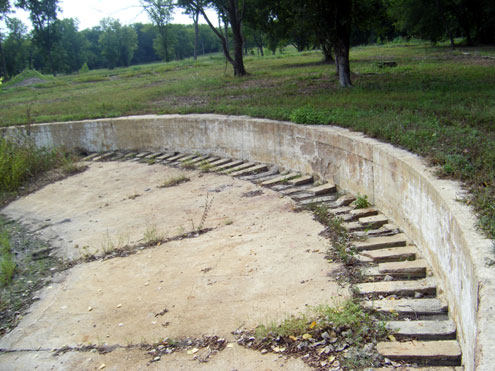
The same article also reported that new machinery was being installed in the roundhouse as well. "It was learned that the company has already installed a lathe, drill press and emery wheel toward the repairing of engines here, and it is thought more machinery will be placed before very long."
The March 11 Dallas News stated that the new equipment would make it possible for more work on a steam engine to be done at Bonham "rather than send the engine to Texarkana or Fort Worth."
The improvements made to the roundhouse and turntable in the first twenty years of the 1900s apparently readied both facilities for the kind of traffic that the T & P saw in the twenties, thirties and through the World War II years. If there were any problems, they apparently didn't make the news; stories virtually disappeared from the headlines.
By the late 1940s the Texas & Pacific Railway began phasing out steam locomotives in favor of diesel-electric engines. By the early 1950s the change was basically complete. Since diesels could travel farther on less maintenance and fewer repairs, there was less need for roundhouses. Some were kept and converted to storage space. Others, including the one in Bonham, were razed.
Exactly when the roundhouse in Bonham was torn down is anybody's guess. However, research does suggest roughly a five year window. Perhaps the last story on the roundhouse to appear in print was in the July 18, 1944 Bonham Daily Favorite. It was a lighthearted piece about the foreman and employees having problems with a mother squirrel and her pups.
Another clue is a 1932 Sanborn Fire Insurance map of Bonham. Updated to show changes to the city's landscape as of November 1949, it clearly shows the turntable in place, but the roundhouse is gone.
It is safe, therefore, to say that the Texas & Pacific roundhouse, a structure that housed many employees, oversaw thousands of repairs and held forth for over six decades as a centerpiece in the Bonham rail yards, came down sometime between mid-1944 and mid-1949. Locals recall that the turntable was used for a while afterwards, outliving its old friend by a few years.
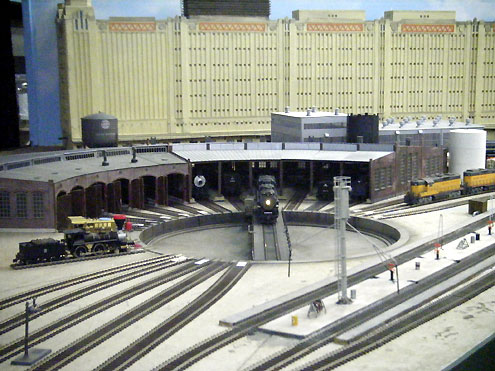
Many thanks to Suzie Henderson for her help in gathering Dallas News clippings; to the ladies at the Bonham Public Library for their patience and sharing of newspaper clippings; to Darrell Cowles of the Texas Western Model Railroad Club of Fort Worth for answering my many questions; and to Fannin County Historical Museum curator Tom Scott for informing me some years back that Bonham once had a roundhouse.
Anyone with photos of the roundhouse or any information on exactly when it was torn down is free to contact me at:
tim.davis@bonhamisd.org or (903) 227-1772.
Tim Davis teaches at Bonham High School.